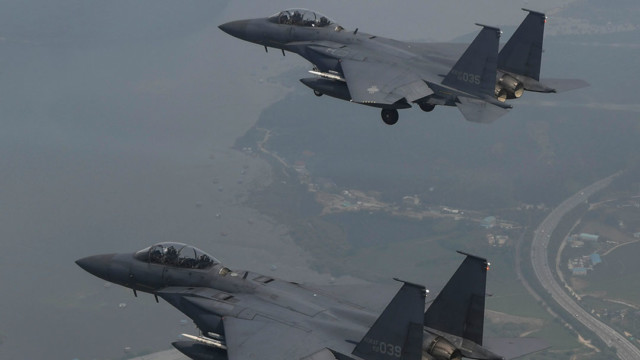The United States flew two supersonic bombers over the Korean Peninsula on Sunday in a show of force against the Democratic People’s Republic of Korea (DPRK) following the country’s latest intercontinental ballistic missile test. The U.S. also said it conducted a successful test of a missile defense system located in Alaska.
The B-1 bombers were escorted by South Korean fighter jets as they performed a low-pass over an air base near the South Korean capital of Seoul before returning to Andersen Air Force Base in Guam, the U.S. Pacific Air Forces said in a statement.
It said the mission was a response to the DPRK’s two ICBM tests this month. Analysts say flight data from the DPRK’s second test, conducted Friday night, showed that a broader part of the mainland United States, including Los Angeles and Chicago, is now in range of Pyongyang’s weapons.
The show of force came as President Donald Trump tweeted about his desire for China to do more, when it comes to the DPRK.
I am very disappointed in China. Our foolish past leaders have allowed them to make hundreds of billions of dollars a year in trade, yet…
— Donald J. Trump (@realDonaldTrump) July 29, 2017
…they do NOTHING for us with North Korea, just talk. We will no longer allow this to continue. China could easily solve this problem!
— Donald J. Trump (@realDonaldTrump) July 29, 2017
Vice President Mike Pence said Sunday during a visit to Estonia that the U.S. and its allies plan to increase pressure on DPRK to end its nuclear program.
“The continued provocations by the rogue regime in North Korea are unacceptable and the United States of America is going to continue to marshal the support of nations across the region and across the world to further isolate North Korea economically and diplomatically,” Pence said. “But the era of strategic patience is over. The president of the United States is leading a coalition of nations to bring pressure to bear until that time that North Korea will permanently abandon its nuclear and ballistic missile program.”
Gen. Terrence J. O’Shaughnessy, Pacific Air Forces commander, called the DPRK “the most urgent threat to regional stability.”
“Diplomacy remains the lead. However, we have a responsibility to our allies and our nation to showcase our unwavering commitment while planning for the worst-case scenario,” O’Shaughnessy said. “If called upon, we are ready to respond with rapid, lethal, and overwhelming force at a time and place of our choosing.”
The U.S. Missile Defense Agency said a Terminal High Altitude Area Defense, or THAAD, system located in Kodiak, Alaska, was successfully tested on Saturday night, Alaska time. It said that a medium-range ballistic missile was air-launched over the Pacific, and that the THAAD system detected, tracked and intercepted the target.
Story by The Associated Press
 CGTN America
CGTN America In this photo provided by South Korea Defense Ministry, a U.S. Air Force B-1B bomber, top, flies with South Korean fighter jets F-15K over Osan Air Base in Pyeongtaek, South Korea, Sunday, July 30, 2017. The United States flew two supersonic bombers over the Korean Peninsula on Sunday in a show of force against North Korea following the country’s latest intercontinental ballistic missile test. (South Korea Defense Ministry via AP)
In this photo provided by South Korea Defense Ministry, a U.S. Air Force B-1B bomber, top, flies with South Korean fighter jets F-15K over Osan Air Base in Pyeongtaek, South Korea, Sunday, July 30, 2017. The United States flew two supersonic bombers over the Korean Peninsula on Sunday in a show of force against North Korea following the country’s latest intercontinental ballistic missile test. (South Korea Defense Ministry via AP)
